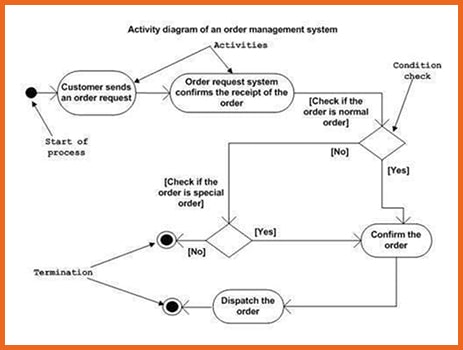Activity Diagram
The Activity Diagram is another important diagram in UML to describe the dynamic aspects of the system. The Activity Diagram is a flowchart to represent the flow from one activity to another activity. The activity can be described as an operation of the system. The control flow is drawn from one operation to another. This flow can be sequential, branched, or concurrent. Activity diagrams deal with all types of flow control by using different elements such as fork, join, etc.

Purpose of Activity Diagrams
The basic purposes of activity diagrams are similar to the other four diagrams. It captures the dynamic behavior of the system. The other four diagrams are used to show the message flow from one object to another but the activity diagram is used to show the message flow from one activity to another.
Activity is a particular operation of the system. Activity diagrams are not only used for visualizing the dynamic nature of a system, but they are also used to construct the executable system by using forward and reverse engineering techniques. The only missing thing in the activity diagram is the message part.
It does not show any message flow from one activity to another. The Activity Diagram is sometimes considered as the flowchart. Although the diagrams look like a flowchart, they are not. It shows different flows such as parallel, branched, concurrent, and single.
The purpose of an activity diagram can be described as
Draw the activity flow of a system.
Describe the sequence from one activity to another.
Describe the parallel, branched, and concurrent flow of the system.
How to Draw an Activity Diagram?
Activity diagrams are mainly used as a flowchart that consists of activities performed by the system. Activity diagrams are not exactly flowcharts as they have some additional capabilities. These additional capabilities include branching, parallel flow, swim lane, etc.
Before drawing an activity diagram, we must have a clear understanding of the elements used in the activity diagram. The main element of an activity diagram is the activity itself. An activity is a function performed by the system. After identifying the activities, we need to understand how they are associated with constraints and conditions.
Before drawing an activity diagram, we should identify the following elements
Activities
Association
Conditions
Constraints
Once the above-mentioned parameters are identified, we need to make a mental layout of the entire flow. This mental layout is then transformed into an activity diagram.
Following is an example of an activity diagram for the order management system. In the diagram, four activities are identified which are associated with conditions. One important point should be clearly understood an activity diagram cannot be exactly matched with the code. The activity diagram is made to understand the flow of activities and is mainly used by business users
The following diagram is drawn with the four main activities
Send order by the customer
Receipt of the order
Confirm the order
Dispatch the order
After receiving the order request, condition checks are performed to check if it is a normal or special order. After the type of order is identified, dispatch activity is performed and that is marked as the termination of the process.
Where to Use Activity Diagrams?
The basic usage of the activity diagram is similar to the other four UML diagrams. The specific usage is to model the control flow from one activity to another. This control flow does not include messages.
The Activity Diagram is suitable for modeling the activity flow of the system. An application can have multiple systems. The Activity Diagram also captures these systems and describes the flow from one system to another. This specific usage is not available in other diagrams. These systems can be databases, external queues, or any other system.
We will now look into the practical applications of the activity diagram. From the above discussion, it is clear that an activity diagram is drawn from a very high level. So it gives a high-level view of a system. This high-level view is mainly for business users or any other person who is not a technical person.
This diagram is used to model the activities which are nothing but business requirements. The diagram has more impact on business understanding rather than on implementation details.
Activity diagram can be used for
Modeling workflow by using activities.
Modeling business requirements.
High-level understanding of the system’s functionalities.
Investigating business requirements at a later stage.
Leave a Reply
Want to join the discussion?Feel free to contribute!